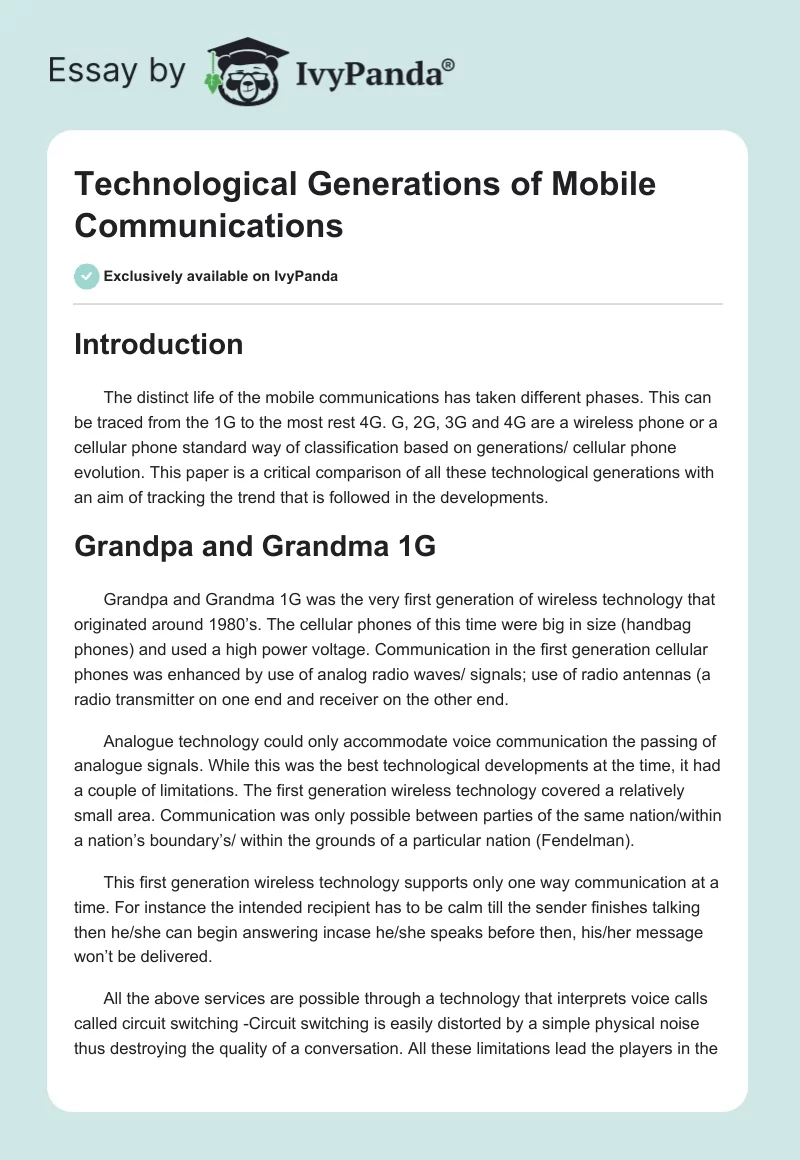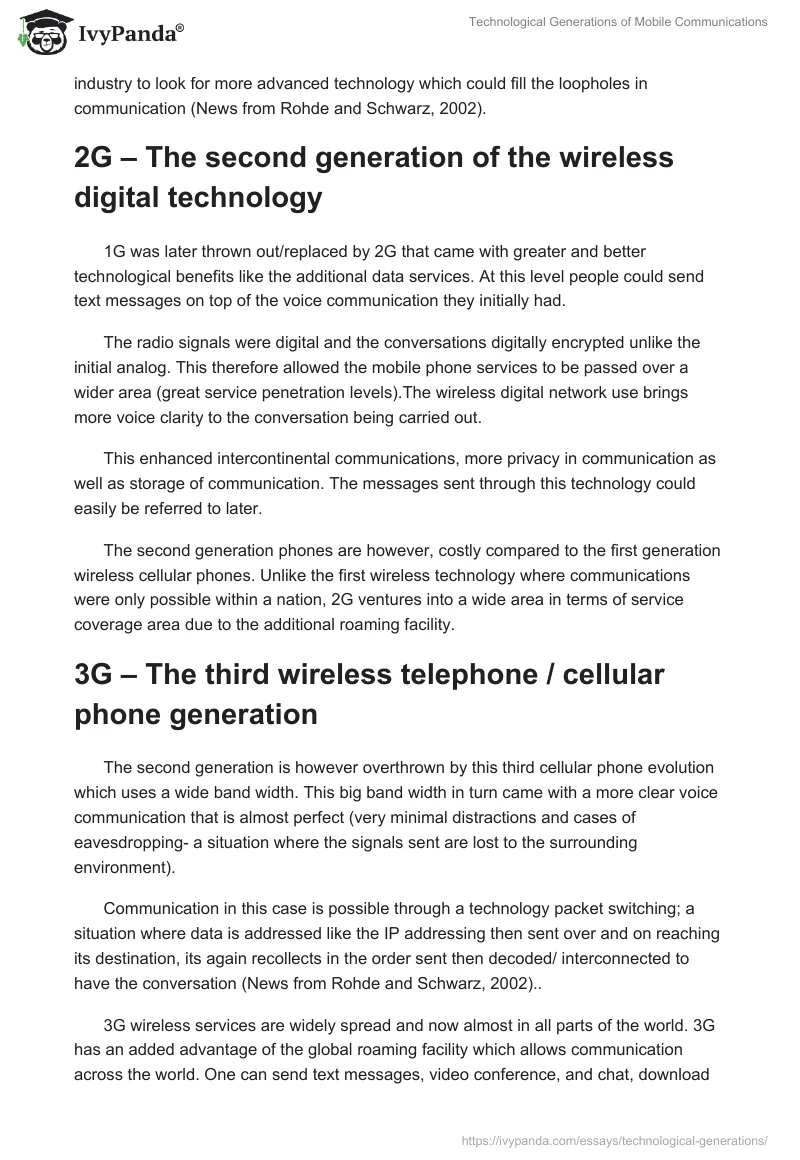Introduction
The distinct life of the mobile communications has taken different phases. This can be traced from the 1G to the most rest 4G. G, 2G, 3G and 4G are a wireless phone or a cellular phone standard way of classification based on generations/ cellular phone evolution. This paper is a critical comparison of all these technological generations with an aim of tracking the trend that is followed in the developments.
Grandpa and Grandma 1G
Grandpa and Grandma 1G was the very first generation of wireless technology that originated around 1980’s. The cellular phones of this time were big in size (handbag phones) and used a high power voltage. Communication in the first generation cellular phones was enhanced by use of analog radio waves/ signals; use of radio antennas (a radio transmitter on one end and receiver on the other end.
Analogue technology could only accommodate voice communication the passing of analogue signals. While this was the best technological developments at the time, it had a couple of limitations. The first generation wireless technology covered a relatively small area. Communication was only possible between parties of the same nation/within a nation’s boundary’s/ within the grounds of a particular nation (Fendelman).
This first generation wireless technology supports only one way communication at a time. For instance the intended recipient has to be calm till the sender finishes talking then he/she can begin answering incase he/she speaks before then, his/her message won’t be delivered.
All the above services are possible through a technology that interprets voice calls called circuit switching -Circuit switching is easily distorted by a simple physical noise thus destroying the quality of a conversation. All these limitations lead the players in the industry to look for more advanced technology which could fill the loopholes in communication (News from Rohde and Schwarz, 2002).
2G – The second generation of the wireless digital technology
1G was later thrown out/replaced by 2G that came with greater and better technological benefits like the additional data services. At this level people could send text messages on top of the voice communication they initially had.
The radio signals were digital and the conversations digitally encrypted unlike the initial analog. This therefore allowed the mobile phone services to be passed over a wider area (great service penetration levels).The wireless digital network use brings more voice clarity to the conversation being carried out.
This enhanced intercontinental communications, more privacy in communication as well as storage of communication. The messages sent through this technology could easily be referred to later.
The second generation phones are however, costly compared to the first generation wireless cellular phones. Unlike the first wireless technology where communications were only possible within a nation, 2G ventures into a wide area in terms of service coverage area due to the additional roaming facility.
3G – The third wireless telephone / cellular phone generation
The second generation is however overthrown by this third cellular phone evolution which uses a wide band width. This big band width in turn came with a more clear voice communication that is almost perfect (very minimal distractions and cases of eavesdropping- a situation where the signals sent are lost to the surrounding environment).
Communication in this case is possible through a technology packet switching; a situation where data is addressed like the IP addressing then sent over and on reaching its destination, its again recollects in the order sent then decoded/ interconnected to have the conversation (News from Rohde and Schwarz, 2002)..
3G wireless services are widely spread and now almost in all parts of the world. 3G has an added advantage of the global roaming facility which allows communication across the world. One can send text messages, video conference, and chat, download 3dimentional games, and talk to any one and anywhere in this world without distractions like they are having real conversation (News from Rohde and Schwarz , 2002).
3G uses a higher band width also a wide band voice channel compared to the 1G and 2G generations which greatly attributes to high voice clarity and people can talk without any disturbance or with very minimal distractions.
There is an additional multimedia facility brought about by this third generation cellular phones like very fast communication (conversations and text messaging), video conferencing (hold video meetings with people in different locations), internet (surfing/browsing/online chatting), mobile television (watch television’s favorite programs on phone), video calls (like Skye), multi media messaging service (MMS) (sharing of photos and music), etc are now available on 3G phones (Arshad, Farooq, Shah, 2010)
The 3G phones are costly compared to the first and second wireless cellular phone generation. Currently 3G is widely in use. Almost everyone is moving or has moved to 3G technology for its interesting features and high speed wireless service.
Despite the numerous advantages to using this kind of phone and very interesting features, 3G wireless telephones however have short battery life compared to the second and first generation phones. Thus the use of this technology is dependent on the proximity to power supply. In remote areas thus, persons are forced to use less advanced technologies to avoid frustrations.
However, some wireless technology users use both technologies concurrently (Arshad, Farooq, Shah, 2010). 3G technology is usually common for users who depend on the wireless communication in internetworking. Most of the service providers carry out promotional advertisements encouraging users to use the technology based on its speed and coverage.
4G – The fourth generation wireless telephones / cellular phone service also known as a complete 3G replacement.
4G operates more like 3G much as it is a step up from 3G. It appears to operate in a hopeful state, like providing its clients with very speedy wireless services. Being the new born baby this fourth generation wireless technology is availed in limited places/areas.
It’s not widely spread and only in use in very few regions like Japan. 4G is anticipated and designed to deliver very high speed internet and generally high wireless services. Also a high network capacity-allowing more people to operate/ access its resources simultaneously (Fendelman,).
They too have the multimedia added feature but with very clear voice and video output compared to the initial generations just like the normal television. The fourth generation cellular phones are damn expensive (high cost) compared to the previous generations. The costs mentioned here are the installation costs. However, the technological requires less maintenance costs.
Similarities
All the above mentioned technologies are wireless technologies. They all are able to pass/enhance analog communication. They all can pass voice communications. The first and Second generation covers a relatively small area in terms of geographical boundaries. Each of the technological development has come with increased area coverage than the preceding development.
Both the first and Second generation use a narrow band width, while the third and fourth generation uses wide band width. Both 1G and 2G deal/ are good in voice calls and in the process need to utilize the maximum bandwidth provided (Ashiho, 2003)
Conclusion
The technological development in the wireless communication has grown from one phase to another. As each phase is introduced, it leads to changes in other industries that depend on this technology for communication and other purposes. It is paramount to note that each of the above technologies has its own specifications.
Thus, there is always a need for any firm to have a technician who shall introduce the members of the institutions on how to operate the different technological developments. The ability of a firm to use the most modern technology is for its advantage as this leads to less maintenance costs. The only additional costs in the generational growth are the initial installation costs (Ashiho, 2003).
The developments that have been discussed in this paper have been enhanced by various firms and individuals. The need for the improvements has always rendered the players in the wireless communication busy with efforts of improving each of the development.
While the current technology is viewed by many as perfect, it is expected that a need will arise for the provision of services that it does not offer. Thus, it is arguable to conclude that the development in the wireless communication cannot be optimum.
References
Arshad, j., Farooq, A., Shah, A., (2010) Evolution and Development Towards 4th Generation (4G) Mobile Communication Systems. Web.
Ashiho, L. S. (2003). Mobile Technology: Evolution from 1G to 4G. Web.
Fendelman, A. (n.d). Cell Phone Glossary: What is 1G vs. 2G vs. 2.5G vs. 3G vs. 4G? Web.
News from Rohde and Schwarz (2002). Measuring the Acoustic Characteristics of 3G Mobile Phones. Web.
Peter, K. (n.d). Analysis and Comparison of 1G, 2G, 3G, 4G and 5G Telecom Services. Web.


